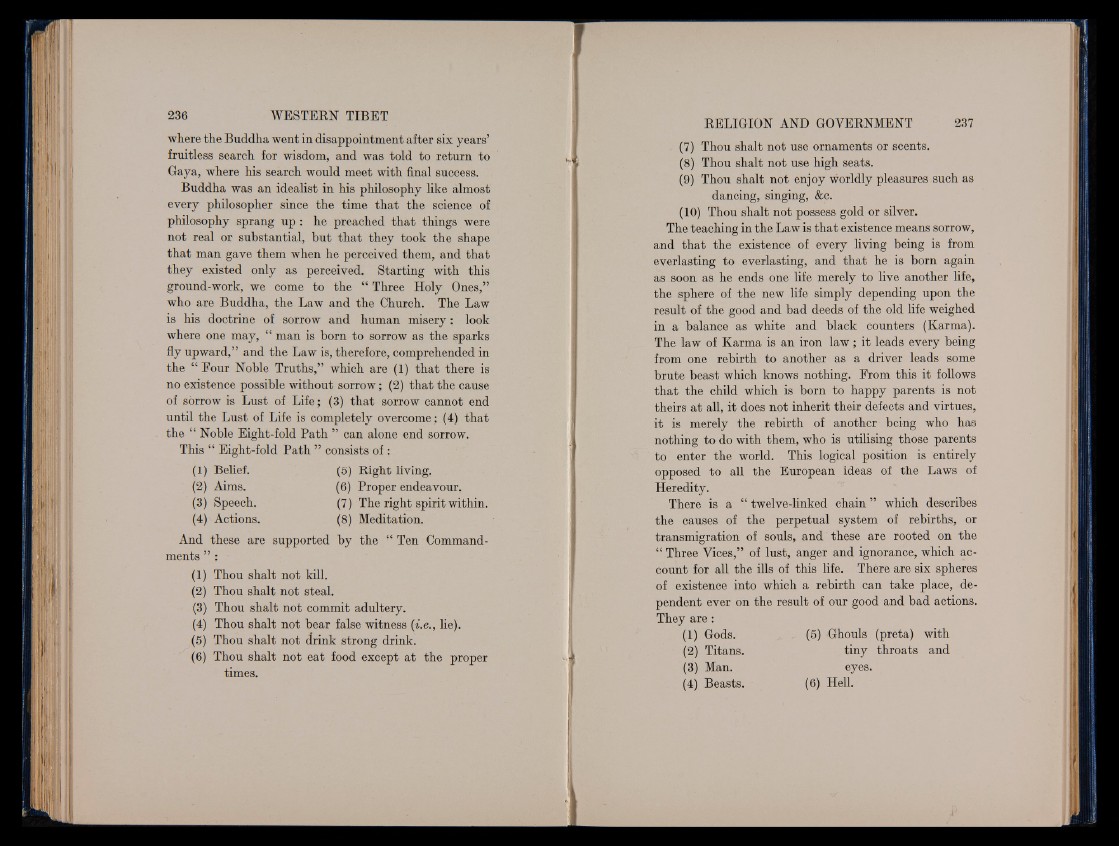
where the Buddha went in disappointment after six years’
fruitless search for wisdom, and was told to return to
Gaya, where his search would meet with final success.
Buddha was an idealist in his philosophy like almost
every philosopher since the time that the science of
philosophy sprang up : he preached that things were
not real or substantial, but that they took the shape
that man gave them when he perceived them, and that
they existed only as perceived. Starting with this
ground-work, we come to the “ Three Holy Ones,”
who are Buddha, the Law and the Church. The Law
is his doctrine of sorrow and human misery: look
where one may, “ man is born to sorrow as the sparks
fly upward,” and the Law is, therefore, comprehended in
the “ Four Noble Truths,” which are (1) that there is
no existence possible without sorrow; (2) that the cause
of sorrow is Lust of Life; (3) that sorrow cannot end
until the Lust of Life is completely overcome; (4) that
the “ Noble Eight-fold Path ” can alone end sorrow.
This “ Eight-fold Path ” consists of :
(1) Belief. (5) Right living.
(2) Aims. (6) Proper endeavour.
(3) Speech. (7) The right spirit within.
(4) Actions. (8) Meditation.
And these are supported by the “ Ten Commandments
” :
(1) Thou shalt not kill.
(2) Thou shalt not steal.
(3) Thou shalt not commit adultery.
(4) Thou shalt not bear false witness {i.e., lie).
(5) Thou shalt not drink strong drink.
(6) Thou shalt not eat food except at the proper
times.
(7) Thou shalt not use ornaments or scents.
(8) Thou shalt not use high seats.
(9) Thou shalt not enjoy worldly pleasures such as
dancing, singing, &c.
(10) Thou shalt not possess gold or silver.
The teaching in the Law is that existence means sorrow,
and that the existence of every living being is from
everlasting to everlasting, and that he is born again
as soon as he ends one life merely to live another life,
the sphere of the new life simply depending upon the
result of the good and bad deeds of the old life weighed
in a balance as white and black counters (Karma).
The law of Karma is an iron law ; it leads every being
from one rebirth to another as a driver leads some
brute beast which knows nothing. From this it follows
that the child which is born to happy parents is not
theirs at all, it does not inherit their defects and virtues,
it is merely the rebirth of another being who has
nothing to do with them, who is utilising those parents
to enter the world. This logical position is entirely
opposed to all the European ideas of the Laws of
Heredity.
There is a “ twelve-linked chain ” which describes
the causes of the perpetual system of rebirths, or
transmigration of souls, and these are rooted on the
“ Three Vices,” of lust, anger and ignorance, which account
for all the ills of this life. Thère are six spheres
of existence into which a rebirth can take place, dependent
ever on the result of our good and bad actions.
They are :
(1) Gods. . (5) Ghouls (prêta) with
(2) Titans. tiny throats and
(3) Man. eyes.
(4) Beasts. (6) Hell.